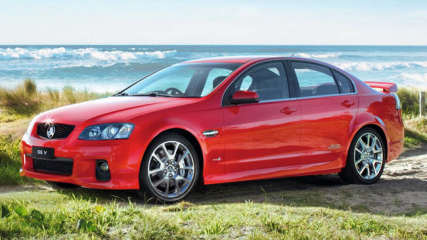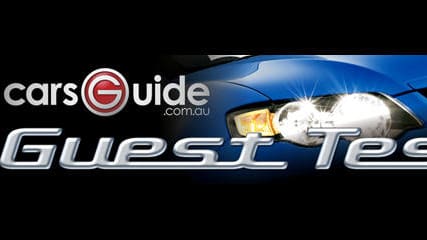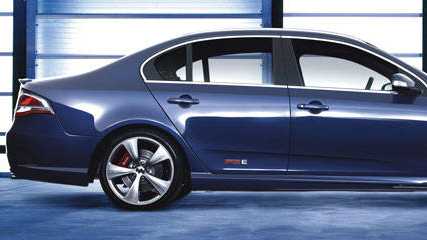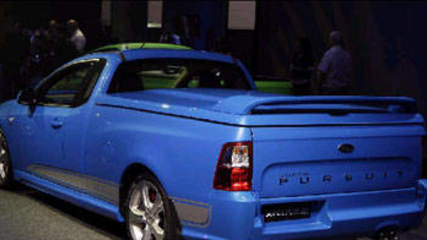FPV F6 News

V8 cars are special
Read the article
By Mark Hinchliffe · 14 Jul 2011
Even at a time when fuel economy is top-of-mind with a growing number of Australian drivers there is plenty of space on the roads for Commodores and Falcons with old-fashioned V8 muscle under the bonnet. They burble menacingly at idle. They are the backbone of V8 Supercar racing.Yet V8s in the 21st century are not what they were in the days when they first conquered Mount Panorama and a GTHO Falcon or a Monaro - or even a Valiant V8 - was a dream machine for a generation of Aussie youngsters.Since 1970 the crude oil price has exploded from $20 a barrel to double that amount during the Iran revolution, over $70 during the first Gulf War, broke through the $100 barrier ahead of the Global Financial Crisis and has now settled at just below $100.In Australia, petrol prices have correspondingly risen from about 8c a litre in 1970 to about 50c in 1984 and almost $1.50 today.Despite all this, and despite one attempt at a death sentence by Ford in the 1980s, the V8 has not been wiped from Australian showrooms. Holden and Ford have continued to produce large cars with a V8 alternative and continue to slog it out at Bathurst.But Australian cars, even the ones that now have American V8s imported for local use, are not the only bent-eight blasters on the road.Germans are prolific builders of V8s and produce some of the most powerful engines in the world thanks to AMG-Mercedes, BMW and Audi. English V8s are built by Aston Martin, Land Rover and Jaguar, while the Americans provide V8s in the Chrysler 300C sold here. Even the Japanese luxury brand Lexus has a V8 in its IS F hero and its luxury saloon LS460, as well as the LandCruiser-cloned LX470.Most V8s are powerful enough breathing ordinary air, but there are many forced-induction models with either turbo or supercharging to liberate even more power. Walkinshaw Performance does the job in Australia for Holden, BMW is going down the turbo V8 road for its latest M cars and Benz had a time with a supercharged AMG V8.But V8s are not just about unrestricted power. The push for greater fuel economy has also reached V8 land and so Chrysler and Holden have V8s with multiple displacement technology which shuts down half the cylinders when the car is just cruising to improve fuel economy. Formula One racing engines now do the same thing when they are idling on a grand prix starting grid.Holden's Active Fuel Management (AFM) was introduced on the V8 Commodore and Caprice in 2008 and the red lion brand is committed to the engine - with future technology updates - despite near-record fuel prices."It is incumbent on us to keep it relevant and continue introducing new technology that delivers on our customers' needs," says Holden's Shayna Welsh.Holden has the biggest stake in V8s with more models than any other company selling in Australia. It has a total of 12 models with V8 engines across four nameplates and four body styles, including Commodore SS, SS V, Calais V, Caprice V and the recently introduced Redline range. V8s account for about one quarter of Commodore sedan sales and almost half of Ute sales."We see it as being more than just the V8 engine - it's about the entire car. It's the whole performance package that appeals to people and we want to continue making cars that people are proud to own," Welsh says."The combination of features and technology, great handling and braking and outstanding value is consistent across our V8 model range."Ford fans are also committed to V8s, according to company spokesperson Sinead McAlary, who says a recent Facebook survey was overwhelmingly positive."We asked whether they worry about petrol prices and they say 'No, it's the sound of the V8 we love and we are prepared to pay the price'," she says.Both Ford and Holden also have performance divisions where the V8 was, and still is, king. Ford's is Ford Performance Vehicles (FPV) and Holden's is Holden Special Vehicles (HSV).HSV marketing manager Tim Jackson says their sales are "on par" with last year."That's despite the fact that last year we had the limited edition GX-P which is an entry level product for us," he says. "We don't have that model in our range at all this year and you would expect numbers to come off, but we've been able to maintain sales volume."All of HSV's range are powered by a naturally aspirated V8 engine (6200cc 317kW-325kW), while the opposition at FPV has gained the kilowatt advantage with forced induction (supercharged 5000cc 315kW-335kW).Jackson says their LS3 V8 has been "validated" by customers."We're not getting guys screaming at us to go turbocharging. The LS3 is an extraordinary unit. It's a light engine with a good power-to-weight figure. There is not a turbo engine that would do it for us at the right development cost. But I wouldn't rule it (turbo) out or rule it in."Jackson says there have been no repercussions from the rise in petrol prices."Our customers don't have other choices in their repertoire," he says. "A small car doesn't suit them and they're not into an SUV. They're of a certain level where the whole cost of running the car is easy for them to absorb."The top-selling HSV is the ClubSport R8, followed by the Maloo R8, then GTS.However, the greatest HSV in history is debatable, Jackson says.HSV engineering boss Joel Stoddart prefers the all-wheel-drive Coupe4 and sales boss Darren Bowler the SV5000."The Coupe4 is special because of its engineering but I like the W427 because it's the fastest," Jackson says.FPV boss Rod Barrett says they are also experiencing strong sales growth. He says they sold about 500 cars in the first quarter, which is up 32 per cent on the previous year. He also says sales of the F6 have slowed since the launch of the supercharged V8 engine variants late last year, as customers "opt for power". Ford no longer offers a V8 with the demise of the XR8 sedan and ute last year."Our middle name is performance so we have all the V8s," Barrett says. "When we were launching this new supercharged car all the V8s came across here."Barrett says their supercharged engine has changed people's minds about "dinosaur V8s"."The turbocharged F6 was a cult hero car in its day and people thought a V8 was a low-tech dinosaur," he says. "But when we produced a high-tech all-alloy five-litre supercharged V8 built in Australia people started to think that V8s aren't all that bad after all. I'm not seeing the demise of the V8 just yet, but for us, the future is hi-tech."The supercharged 5.0Litre V8 335kW FPV GT continues to be FPV's top-selling vehicle followed closely by the supercharged V8 5.0 litre 315kW GS sedan and GS ute.Barrett believes the current GT is the best FPV car yet with its segment-leading power, light weight and improved fuel economy."However, I think our most iconic car was the 2007 BF Mk II 302kW Cobra in white with blue stripes. That car brought back the passion of '78 with the original Cobra. If you have a look at the second-hand prices, they are still holding up very well" he says.

Be the Carsguide FPV Guest Tester
Read the article
By CarsGuide team · 13 Aug 2009
...following on the heels of the hot F6 E unveiled a couple of weeks ago.And one lucky Carsguide reader will be among the first to get behind the wheel of this awesome machine as our Guest Tester.The new vehicle will be released nationally on September 1, but FPV is not releasing much in the way of detail, except to say the mystery car will again pay tribute to Ford’s rich muscle car history.“Our next model to be revealed is something we’re really excited about,” FPV’s general manager Rod Barrett said. “The beauty of being a local manufacturer is that we can respond relatively quickly to market demand.“And this new V8 vehicle -- along with our recently released F6 E -- is a product that we envisage will be warmly welcomed by fans of the blue oval,” he added.“With plenty of FPV DNA running through its veins, our new addition will, like the rest of our range, be easily identified on the street and from behind the wheel as an FPV product.”And you could be the one to fly to Melbourne to drive this car for a weekend in October, as Carsguide’s Guest Tester. You’ll also have a guided tour of the FPV and Ford Performance Racing workshops, hosted by one of FPR’s V8 Supercar drivers.After the test drive, your review of the car will be published on carsguide.com.au, with photos of you at work behind the wheel.To enter, in the Comments box below tell us in 50 words or less why you want to win. Do not provide telephone numbers or house address, but let us know if you saw the competition in your local newspaper and which one it was.This competition has now closed.You must be over 25 and hold a current full manual licence to enter. Tell us if you saw the competition in your local newspaper's Carsguide section - because during each of the four weeks of the competition, each participating newspaper will announce a ‘shortlist’ winner from among their readers, who gets a great FPV prize package worth $80. Check back in your paper each week to see if that’s you.The competition closes at 5pm EST, Friday September 11, and the name of the Guest Tester will be announced in your local Carsguide section, and here, the following week.This competition has now closed.This competition has closed, and with all the great entries, the Carsguide Guest Tester judges had a difficult task. But the final winner was Nikki Robbins of Brisbane, with: “Our FPV who art not released, What say be they name? Thy colour range? Thy engine size? On quarter-miles how shall thee run? Give us thine fearless V8 brute strength, Forgive thee less-fortunate in Holdens, Lead us not into disappointment, But deliver us thine test-drive, Ford ever-and-ever, amen.” Congratulations to Nikki, and to all the entrants — there’ll always be next year...

FPV F6 E unveiled
Read the article
By Kevin Hepworth · 04 Aug 2009
"What you are going to get is 310kW and 565Nm in something that looks like a 5 Series BMW," Ford Performance Vehicles boss Rod Barrett says. "When you put your foot down it is going to go ... and at a pretty good price advantage. "This really is our Euro competitor."At $79,740 the F6 E - built off Ford's award-winning G6 E Turbo at a price premium of $23,000 - slips into the FPV range alongside the V8-powered GT-E."I think it is more about choice," Barrett says. "We make these iconic go-fast cars like the F6 and the GT and that is the base of our range ... it's what our core business is about. But there are some people that we do not cater for in that range that want a bit more luxury and refinement."They don't want stripes and big wings and black wheels. They want a bit more leather and woodgrain and chrome and I don't want to lose them."Barrett says the overwhelming success of the F6 and the demand for the G6 E Turbo was enough for FPV to shift plans for the F6 E off the back burner and give it some exposure as a concept car at the Melbourne Motor Show earlier this year."It was obvious that there is a demand there for it - not significant, but a demand," Barrett says.The F6 E will be built as a limited production vehicle with plans for ‘less than 50’ this year."It is not a limited edition just a limited production run," Barrett says. "If it were to take off and there was demand for 100 or a 150 then we just keep building them - it's there to be built."Barrett says the F6 E is another model in the FPV range against which rivals HSV cannot set a direct competitor. "They have the Senator in V8, which I would say is our GT E competitor, but they don't have a turbo six and this is the luxury version of that F6. I really think the top end of town will take to this car ... it will cater for the non-V8 crowd."The F6 E is powered by Ford's proven 4-litre turbo-charged DOHC 24 valve in-line six coupled to the ZF six-speed high-torque automatic transmission with Sequential Sports Shift.In keeping with the luxury theme the cabin features seats in shadow leather with the F6 E logo embossed on the headrests, a dark walnut woodgrain finish on the dashboard and doors, sports leather steering wheel with cruise control and audio mounted switches, dual-zone air conditioning and memory on adjustable pedals.Dynamic stability control, side curtain airbags, reverse parking camera and reverse sensing system, electronic brakeforce distribution and ABS are also standard.Barrett says FPV sales have held up better than the industry-standard large cars numbers with 911 sales year to date against 1154 for the same period last year."Under the circumstances I will take that ? especially when you consider last year we were launching new models and had the Cobra sales," Barrett says.

FPV's latest winners
Read the article
By Stephen Ottley · 22 Feb 2008
FPV will not enter a power war with arch-rival HSV with its new FG series Falcon.

Typhoon creates a storm
Read the article
By Stuart Martin · 10 Oct 2007
FPV has released a limited-edition F6 R-Spec Typhoon, debuting the R-Spec suspension and handling package in the turbo-six range.The R-Spec badge, a rear spoiler and different wheel treatments are standard on the tweaked car, of which there will only be 300.New FPV general manager Rod Barrett said the positive response to the GT 40th Anniversary limited edition, which was the first FPV to feature the R-Spec handling package, has prompted the new model.“The initial idea behind R-Spec was to provide an FPV vehicle for those people who wanted to be more competitive at track days and club sprint events, but who didn't want to compromise on the comfort of daily driving, either,” he said.Barrett has come across from the racing side of the business, having been commercial director of Ford Performance Racing for the past few years.Before that, Barrett's CV includes sales and marketing roles in Australia, Asia and the UK, including more than a decade of senior management with Coca-Cola and the Fosters Group.Barrett can also lay claim to an international circuit racing motorsport career in the UK and here from 1979 to 1992.He said the GT 40th Anniversary had succeeded in fitting the brief for customers looking for the same suspensions upgrade in a turbo-six Typhoon.He also said FPV has customised the R-Spec package to maximise the handling characteristics of the Typhoon, allowing the F6 R-Spec drivers to extract the best possible performance out of their vehicle.“The set-up on the F6 is different to our Boss 290 package to account for the different mass of the Typhoon,” Mr said. “The most significant change has been to the front-end damper tune.“Importantly, we have maintained an impressive level of ride comfort. The R-Spec package picks up more road irregularities.“However, we have maintained the supple ride that has earned FPV cars an enviable ride and handling reputation.”The driveline is unchanged, meaning the revamped underpinnings do a better job of getting the turbo six's 270kW (at 5000rpm) and the mesa-like torque curve that shows 550Nm (between 2000 and 4250rpm) to ground.FPV said the forced-induction six-cylinders represent between 30 and 40 per cent of all FPVs sold.The interior gets leather seats as standard, as well as FPV floor mats with the F6 R-spec logo, an iPod/MP3 audio player connection, but exterior paint colours are limited to Winter White, Lightning Strike, Vixen, Neo, Ego and Silhouette.The R-Spec model will be available with either a six-speed manual or six-speed automatic transmission, with a starting price of $63,310, up from the standard F6 price of $61,810.While 2144 sales for 2006 was a record year for FPV, 2007 numbers are about 170 units down in year-to-date terms.The company is aiming to make up for the shortfall with several limited-edition models in the next six months to finish off the year with ' strong sales result.'

Typhoon gets R-spec tag
Read the article
By Neil McDonald · 25 Aug 2007
It may be treading water at the moment when it comes to new models, but Ford Performance Vehicles still has some tricks up its sleeve.To keep buyer interest bubbling along it has released a limited-edition F6 R-spec Typhoon.The R-spec is one of three limited-edition cars planned in the run up to the new Orion-based hot FPV Falcons, which will reach showrooms in about nine months.The others are expected to be the Cobra Falcon and ute and an FPV Territory in October.Only 300 R-spec Typhoons will be built, with a beefier suspension and handling package.The engine specifications remain the same; a turbocharged 4.0-litre, six-cylinder developing 270kW at 5000 revs and 550Nm from 2000 revs.The F6 R-Spec is the first of Ford Performance Vehicles' six-cylinder models to get this package.The car is identified with distinctive badging and dark argent gunmetal accents on the wheels and rear spoiler.It will come with its own build certificate of authenticity.FPV general manager Rod Barrett says the Typhoon R-spec came about because of the positive response to the 40th-anniversary GT limited edition, the first FPV to feature the R-Spec handling package.All 200; 40th-anniversary GTs were snapped up by enthusiasts.“The initial idea behind R-Spec was to provide an FPV vehicle for those people who wanted to be more competitive at track days and club sprint events, but who didn't want to compromise on the comfort of daily driving,” Barrett says.FPV has customised the R-Spec package to maximise the Typhoon's handling characteristics, allowing drivers to extract the best possible performance out of their vehicles. The most significant change has been to the front-end damper tune without compromising ride comfort.The cabin includes FPV's leather seats as standard, and FPV floor mats with the F6 R-spec logo inlay match the exterior touches. An iPod/MP3 audio player connection is also fitted as standard and integrates with the stereo.The F6 R-Spec is available with either a six-speed manual or six-speed automatic.Prices start from $63,310, which is $1500 more than for the standard F6 Typhoon.
Ford's powerful wind
Read the article
By CarsGuide team · 21 Jan 2005
Ford's performance arm copped a bit of flak when it announced plans for the Typhoon, with claims that it was "bastardising" the hallowed Aussie performance car genre.Much of the criticism funnily enough seemed to emanate from the Holden camp which does not have a turbocharged power plant of its own.But really, what's all the fuss about?After all, HSV happily produced and marketed the supercharged XU-6 VT Commodore in 1996, didn't it?The future is all about smaller, more powerful engines and five minutes behind the wheel of the Typhoon is enough to convince the most vocal critic that this car deserves to wear the FPV badge.Heck! On paper and on the road, the Typhoon in our estimation has got the wood on V8 stablemate the Falcon GT.The only bit that they haven't managed to engineer into the turbo is that wonderful V8 exhaust note.Available in manual form only, the Typhoon is priced from $58,950, in line with the company's policy of producing uncompromising performance at an affordable price.That's $2400 less than the manual GT – and apart from the GT badge you're not missing out on much.The Typhoon's exterior styling with smallish badges and lack of striping is somewhat understated and we believe could be more overt.The kind of people that drive these cars are not what you'd call shrinking violets.Inside, there's also room for something fancier, particularly with the ordinary dash treatment.Metal starter and gear shift knobs look the goods but get extremely hot if left sitting in the summer sun.And, while on the subject of sun, tall drivers will find the lowered sun visor obstructs vision, even with the driver's seat set to its lowest point.On the road the Typhoon feels lighter and more agile than the V8, although in reality there is only about 50kg difference.The force-fed 4.0-litre DOHC straight six cylinder engine cranks out an impressive 270kW of power and whopping 550Nm of torque from a low 2000rpm, compared to the V8's 290kW and 520Nm from 4500rpm.That's more torque and from much lower in the rev range, which as we all know is the stuff that performance is made of.The Typhoon with a shorter first gear has incredible get up and go, punching through the gears to what surely must be a mid-five second time for the 0-100km/h dash.Think WR-X and then some...In fact, if you do the sums, the power to weight ratio of the Typhoon is 6.6kg per kW, compared to say the top of the line STi Rex which comes in at a 7.5kg.In theory at least, it makes the Typhoon a quicker car, but of course other factors come into play.Apart from the lift in power, most of FPV's tweaking is reflected in the superior handling of the car.It's this rather than straight line performance that makes it so much more desirable than a standard XR6 Turbo.The car sits low and flat with big sticky tyres that hang on for dear life.Traction control is provided and can be switched off if desired but we found it much less intrusive than the standard system and assume this has been the subject of some refinement too.Twin centre mounted, driver orientated dash top gauges show turbo boost and oil pressure.The close ratio six-speed Tremec manual transmission has been specially engineered for the car and is light and easy to use, with an electronic lockout for reverse.The twin plate AP Racing clutch also has a light action, but a couple of the motor magazines have managed to fry a clutch (we're not surprised).Blue caliper performance 325/303mm brakes are standard while red caliper 355/330mm Brembos are optional.Standard equipment includes FPV badged sports with a "suede feel" bolsters, dual climate airconditioning and a 150 watt six stack CD sound system.





